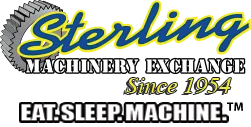Radial Drills are known for drilling, tapping, counterboring and reaming and countersinking. What is the Best Radial Drill to Buy?
A radial drill, also known as a radial arm drill or radial drilling machine, is a type of machine tool used for drilling holes in large or heavy workpieces that are difficult to move. They are commonly used in manufacturing, fabrication, and maintenance workshops and used to drill holes in various materials such as metal, woods, and plastics. The large vertical column of a radial drill, supports the horizontal arm or radial arm allowing rotation the drill head different directions. The rotation creates the ability to reach different positions on the workpiece without repositioning the entire machine. The drill head has a motor, spindle and drill chuck used to raise or lower the height of the workpiece. Radial drills have a wide range of speed and feed settings accommodating various drilling requirements The large vertical column, supports the horizontal arm or radial arm allowing rotation the drill head different directions. The rotation creates the ability to reach different positions on the workpiece without repositioning the entire machine.
- Drilling is the process of creating a hole in a workpiece using a rotating cutting tool called a drill bit. When using a radial drill, the drill bit is mounted on a spindle that can move in different directions. The radial drill allows for positioning the drill bit at various angles and distances from the workpiece. By rotating the spindle and applying axial pressure, the drill bit removes material, creating a hole.
- Tapping is the process of creating internal threads in a pre-drilled hole. It is often used to create threaded holes for screws, bolts, or other fasteners. A tap, is the cutting tool with threads. The tap is inserted into the hole, and as it rotates, it then it cuts and forms the threads in the workpiece.
- Counterboring is the process of enlarging the upper portion of a pre-existing hole to create a flat-bottomed cavity called a counterbore. The purpose of counterboring is to provide a seat or recess for a fastener such as a bolt head, allowing it to sit flush with the surface of the workpiece. With a radial drill, a counterboring tool can be mounted on the spindle and positioned over the existing hole. The tool is then rotated and fed into the hole, removing material and creating the counterbore.
- Reaming is the process of refining and sizing a previously drilled hole to achieve a higher level of precision, smoothness, and accuracy. A reamer is a cutting tool with multiple flutes. With a radial drill, the reaming tool can be attached to the spindle and positioned in the hole. The reamer is rotated and moved in an axial direction to remove a small amount of material and improve the diameter, roundness, and finish off the hole.
- Countersinking is a machining operation used to create a conical recess in a material, typically a metal, to allow the head of a screw, bolt, or rivet to sit flush with or below the surface. It is done to improve the appearance, reduce the risk of snagging or damage, and ensure a secure fit between the fastener and the material.
Determining the capacity of a radial drill is essential. Consider several key specifications and measurements.
- Identify the drill's throat distance: The throat distance refers to the measurement from the center of the column to the center of the spindle. It represents the maximum distance from the column to the drill bit.
- Measure the spindle travel or quill travel: The spindle travel is the maximum vertical distance the spindle can move up and down. It determines the drill's drilling depth capacity.
- Consider the drill bit size: The drill bit size indicates the maximum diameter of the drill bit that the machine can accommodate.
- Evaluate the power and speed capabilities: The power rating of the drill motor and the available speed settings also contribute to the drill's capacity. Higher power and variable speed options enable drilling through tougher materials and larger diameters.
- Consult the experts at Sterling Machinery Exchange and Fabrication. They understand the manufacturer's specifications as they sell both new and used radial drills. Sterling Machinery Exchange will assist you to purchase the right radial drill for your purposes. Knowing the maximum capacities, such as throat distance, spindle travel, and drill bit size is the knowledge we have done for you to make a decision right for your manufacturing purposes.


